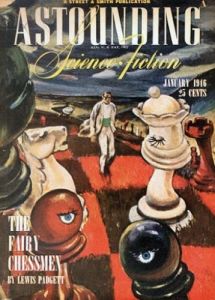 The Fairy Chessmen
The Fairy Chessmen
Henry Kuttner and C. L. Moore writing as Lewis Padgett
originally published in two parts in Astounding Science Fiction, Jan. 1946 and Feb. 1946
I’ve had a copy of this short novel for years but have never gotten around to reading it until recently. For some reason, I struggled a bit to get into to it. That’s not normally a problem I have with Kuttner, even when he isn’t at the top of his game. It may have had something to do with reading it on my phone. I tend to be interrrupted more when I’m reading in that format.
But I digress. Here’s what I thought of the story.
The story is set approximately 100 years in the future from when it was written, it concerns a world that is very different than ours in many ways yet very much the same. There’s a major war on that has been raging for quite a while. Just how long we’re not told, but it’s against a political entity know as the Falangists. There’s no real explanation as to who exactly they are; they’re simply a hostile power. Most people involved the war effort live in large underground cities, which made me think of Phillip K. Dick. The civilian population lives above ground. This novel was very much influenced by the Cold War.
The story opens when Cameron, the Civilian Director of Psychometrics, notices that his doorknob has opened a blue eye and is looking at him. It takes off from there.
I’m not sure how to explain the setup without spoilers, because there are several plotlines that do eventually come together that don’t seem to have much to do with each other initially. Many of Kuttner’s familiar themes are here: time travel, war, psychology, Lewis Carroll, mutants. For instance, there are a number of domes scattered about the countryside. They’re believed to come from the future. There’s also an agent who may be from the future as well.
The main thing driving most of the plot, at least initially, is that the government has managed to get it’s hands on an equation, one the Falangists already have. They’re trying to solve it, but everyone who works on it goes insane. Solved, the equation is a source of great power. The problem is that the constant aren’t, well, constant. Their values change. Which tends to push people over the edge.
This is where the story broke down for me. There was just too much handwaving on this part. I’ve got a technical background and couldn’t buy into the equation part of the story.
That said, there were times when the use of the equation had interesting implications. For instance, while the Falangists have the equation, they haven’t completely solved it. If they had, the war would be over. They’ve started penetrating the force shields the US has in place to protect their cities. They’re also using the equation to play mind games with Cameron, trying to drive him insane. War by psychology, so to speak.
Things seemed to me to move a bit slowly, but that may have been the interruptions I had to put up with while reading it. Pacing isn’t generally a problem with Kuttner’s work from the mid-1940s.
Where Kuttner and Moore really shine in The Fairy Chessmen is Cameron’s hallucinations. He keeps them secret from his two coworkers. They realize something is bothering him but don’t know what. So from time to time, we get to see the world go wonky from Cameron’s point of view. The altimeter on a plane smiles at him. When he looks in a mirror, there are ripples in the mirror every time he blinks. Stuff like that, where inanimate objects take on characteristics, often human characteristics they don’t normally have.
Then there’s the mutant who can see through time. He walks across a room and not only avoids the objects in it, but he avoids things that either were or will be in it at some other time. And he can see everyone’s duration in time.
The Fairy Chessmen is definitely a product of its time. As I said, there are a number of the Kuttners’ familiar themes here. I think after the psychological elements, mutations and time travel are used to best effect. It’s probably not one I’m going to reread soon, but it’s a decent piece of science fiction.


Influenced by the Cold War or foreshadowing the Cold War? That January 1946 issue would have come out in December of ’45. If we figure three to six months from submission to publication, the guns of WWII could have hardly been silenced when the story was written. Yes, those who looked could see the Cold War brewing, but the Kuttners would have to be unusually prescient for it to be a major influence.
Incidentally, those who have not read the story may want to know that Fairy Chess has nothing to do with elves or similar mythological creatures. As the story explains, it is chess with non-standard pieces or non-standard moves for the standard pieces. Wikipedia has a couple of articles that will probably tell more than you want to know …
Good point about the timing on the Cold War. I suspect sf writers in general would be more likely to see it coming than the average person. I seem to recall reading some things from that time period that dealt with wars going on for extended periods of time. I suspect John Campbell may have had a some influence on the writing of this story, and he would almost certainly have seen the Cold War coming.
And thanks for pointing out that fairy chess doesn’t deal with fantasy tropes. I should have mentioned that in the review. That was what I thought it was about at first until I got into the story.